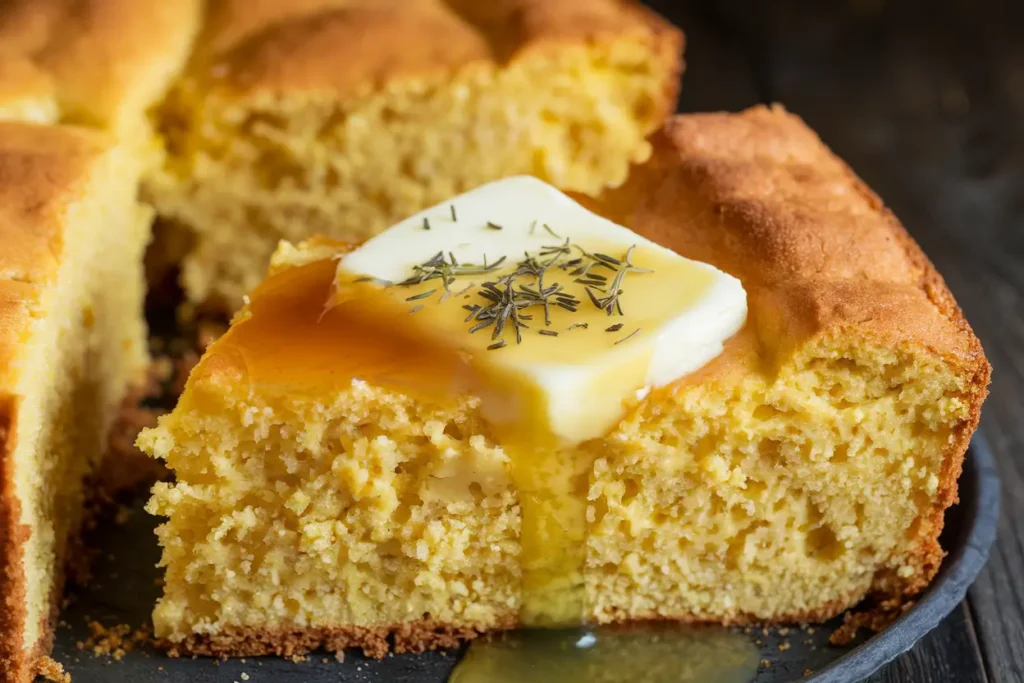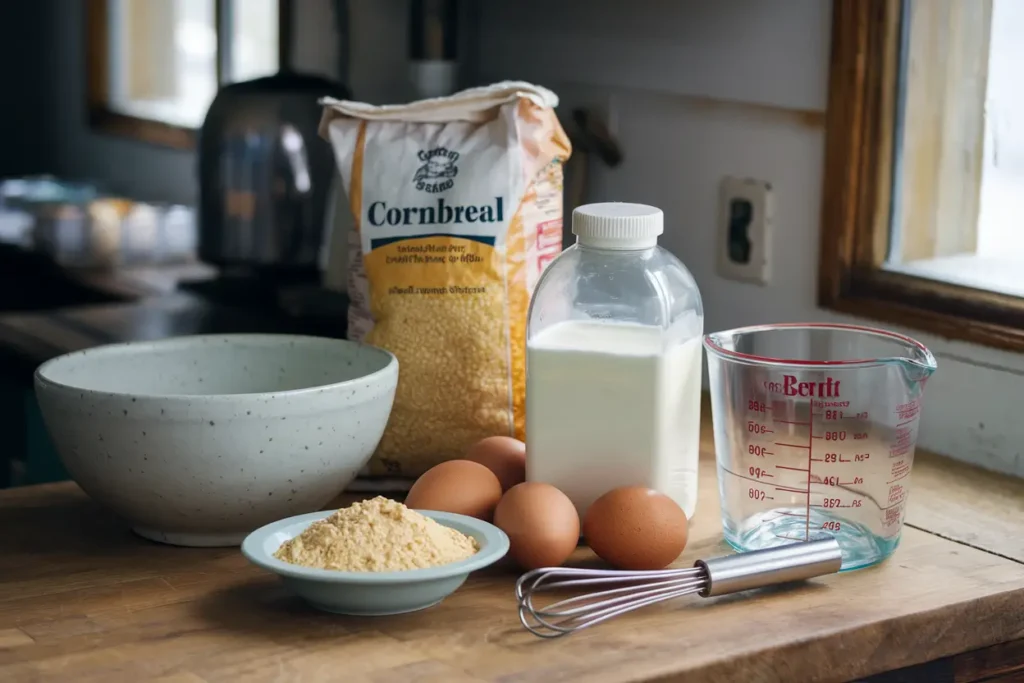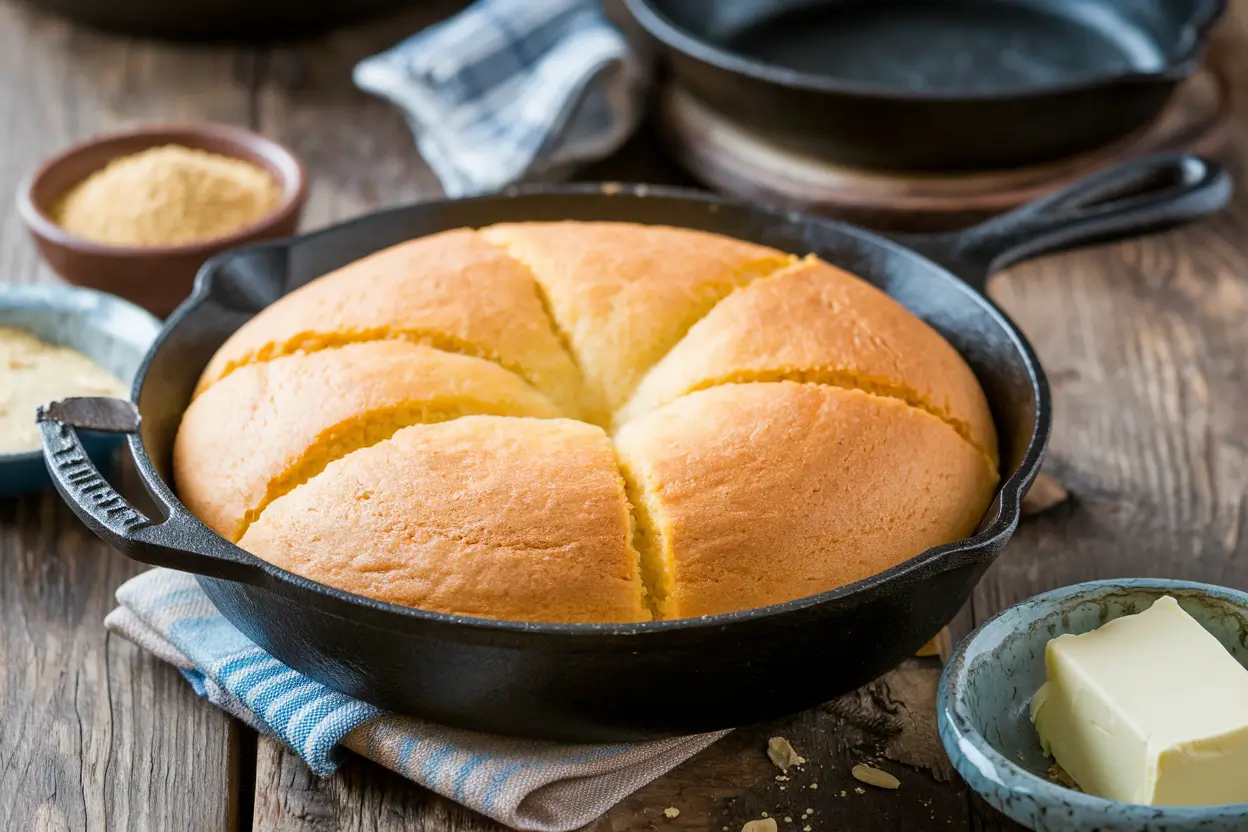Table of Contents
Cornbread is more than just a food item in the South—it’s a cultural cornerstone, a symbol of tradition, and a subject of heated debate. One of the most enduring questions surrounding this beloved dish is: Why do Southerners not put sugar in cornbread? Let’s dive into the origins, traditions, and controversies that make Southern cornbread unique.
Introduction to Southern Cornbread Culture
Cornbread in the South isn’t just a side dish; it’s a way of life. From family dinners to community gatherings, this humble staple represents history, hospitality, and home. Southern cornbread differs significantly from its Northern counterpart, particularly in its lack of sugar. This seemingly small distinction carries deep cultural and historical significance.
What makes Southern cornbread special?
- Texture: Southern cornbread is typically crumbly with a firm crust.
- Flavor: It emphasizes the natural sweetness of corn, enhanced with savory undertones.
- Preparation: Traditionally baked in cast-iron skillets, giving it a crispy edge.
Historical Origins of Cornbread in the South
Cornbread in Colonial America
Cornbread’s roots trace back to Native American cooking, where corn was a dietary staple. Early settlers adopted these recipes, modifying them based on available ingredients. Sugar, often expensive and scarce, wasn’t a common addition. Instead, cornbread became a simple, savory dish made with cornmeal, water, and salt.
Economic and Agricultural Influences on Southern Cornbread
The Southern climate was ideal for growing corn, making it a primary crop. Cornmeal was cheap, accessible, and versatile. During tough economic times, cornbread provided sustenance without the need for luxury items like sugar or refined flour. This practicality became ingrained in Southern cooking, shaping cornbread into the savory staple we know today.
The Role of Cornbread in Southern Cuisine
Traditional Dishes Paired with Cornbread
Cornbread isn’t a standalone dish in Southern meals. It often accompanies:
- Greens like collard or mustard greens.
- Beans and stews such as pinto beans or Brunswick stew.
- Barbecue with its smoky, rich flavors.
These pairings highlight cornbread’s role as a neutral, savory base that complements bold, hearty dishes.
Cornbread Variations Across Southern States
While most Southern cornbread excludes sugar, there are subtle regional differences:
- Texan cornbread might include jalapeños for a spicy kick.
- Appalachian cornbread sometimes incorporates buttermilk for tanginess.
- Louisiana cornbread can feature ingredients like crawfish or okra.
Why Sugarless Cornbread? A Deep Dive
Practical Reasons: Ingredients and Availability
Historically, sugar was expensive and considered a luxury. Southern households prioritized practicality, using simple ingredients that were readily available. Cornbread recipes often relied on the natural sweetness of corn itself.
Flavor Profiles and Southern Palates
Southern cooking emphasizes balance. Adding sugar to cornbread can overpower its intended role as a savory complement. Instead, the subtle sweetness of the cornmeal shines through when paired with salty butter or tangy buttermilk.
The Influence of Tradition and Authenticity
In Southern culture, food is steeped in tradition. Families pass down recipes through generations, and many purists argue that adding sugar dilutes the authenticity of “true” Southern cornbread.
Regional Debates: Sugar or No Sugar?
Modern Adaptations vs. Classic Recipes
Modern cooks sometimes incorporate sugar to cater to broader tastes. However, traditionalists often reject these adaptations, claiming they stray too far from Southern roots.
Perspectives from Southern Cooks and Bakers
Opinions vary even within the South. While some believe sugarless cornbread is non-negotiable, others see room for experimentation. These debates highlight the passionate connection Southerners have with their food.
Common Misconceptions About Southern Cornbread
Myth: All Southerners Agree on Sugarless Cornbread
While many Southerners prefer sugarless cornbread, there’s no universal consensus. Regional and personal preferences play a significant role.
Misunderstandings About Northern and Southern Styles
Northern cornbread, which often includes sugar, isn’t “wrong”—it’s just different. Understanding these differences fosters appreciation for both styles.
Challenges and Controversies Around Cornbread Recipes
Recipe Preservation in a Modern Era
As younger generations adapt recipes to modern tastes, traditional versions risk being lost. Efforts to preserve these recipes are vital for cultural continuity.
Balancing Tradition and Innovation in Cornbread Recipes
Innovations like gluten-free or vegan cornbread have expanded the dish’s appeal, but they also spark debates about authenticity.
How to Make Authentic Southern Cornbread?

Traditional Recipe for Sugarless Cornbread
Ingredients:
- 1 cup cornmeal
- ½ cup flour
- 1 tsp baking powder
- 1 tsp salt
- 1 egg
- 1 cup buttermilk
- 2 tbsp bacon grease or butter
Instructions:
- Preheat your oven and cast-iron skillet to 400°F.
- Mix dry ingredients in a bowl.
- Add egg, buttermilk, and melted bacon grease. Stir until combined.
- Pour the batter into the hot skillet.
- Bake for 20-25 minutes until golden brown.
Tips for Achieving Perfect Texture and Flavor
- Use freshly ground cornmeal for the best taste.
- Preheat the skillet to ensure a crispy crust.
Cultural Significance of Cornbread in Southern Identity

Cornbread as a Symbol of Southern Heritage
Cornbread represents resilience and resourcefulness, values central to Southern culture.
How Cornbread Brings Communities Together?
From church potlucks to family reunions, cornbread plays a unifying role in Southern gatherings.
Frequently Asked Questions About Southern Cornbread
Is Sugarless Cornbread Healthier?
Yes, it typically contains fewer calories and less processed sugar, making it a healthier option.
What’s the Best Type of Cornmeal to Use?
Stone-ground cornmeal is preferred for its robust flavor and texture.
Can You Make Cornbread Gluten-Free?
Absolutely! Replace flour with gluten-free alternatives like almond or rice flour.
Conclusion: Preserving the Legacy of Southern Cornbread
Southern cornbread is more than just food—it’s a story of history, culture, and tradition. Whether you prefer it with or without sugar, there’s no denying its significance in the culinary world.
Regional Debates: Sugar or No Sugar?
Southern cornbread is a dish that inspires fierce loyalty and strong opinions. One of the most debated topics is whether sugar has a place in this iconic recipe. Let’s explore these debates and what they reveal about Southern culinary traditions.
Modern Adaptations vs. Classic Recipes
In today’s culinary landscape, modern adaptations often cater to diverse palates. Some cooks add sugar, honey, or other sweeteners to their cornbread recipes, blending traditional Southern flavors with modern preferences. While these adaptations are delicious in their own right, purists argue that they stray too far from the original purpose of cornbread.
Why is this such a big deal? Traditionalists see sugarless cornbread as a connection to their heritage—a tangible link to the past. Adding sugar, they claim, alters the dish’s identity, turning it into something more akin to cake.
Modern variations of Southern cornbread include:
- Sweet cornbread muffins: A hybrid between cake and bread.
- Cheesy jalapeño cornbread: A spicier, heartier take on the dish.
- Cornbread with maple syrup glaze: Blurring the lines between savory and sweet.
While these variations are creative, they often spark heated discussions about what makes cornbread “authentic.”
Perspectives from Southern Cooks and Bakers
The debate isn’t confined to cookbooks or kitchen tables—it’s a living conversation in communities across the South. Older generations often staunchly defend the sugarless tradition, while younger cooks may feel more open to experimentation.
Notable viewpoints include:
- “Cornbread isn’t dessert!” argue traditionalists, emphasizing the role of savory cornbread in Southern meals.
- “Why not both?” say progressive cooks, who appreciate both styles and enjoy blending old and new.
Despite the differing opinions, one thing is clear: cornbread remains a beloved part of Southern identity.
Common Misconceptions About Southern Cornbread
The sugar debate has also given rise to several misconceptions about Southern cornbread. Here, we’ll clear up some of the most common myths.
Myth: All Southerners Agree on Sugarless Cornbread
It’s tempting to think that every Southerner swears by sugarless cornbread, but the truth is more nuanced. While the majority of traditional recipes exclude sugar, personal and regional preferences vary. For instance:
- Some coastal areas lean toward sweeter recipes influenced by Caribbean and Creole cuisines.
- Urban centers with more cultural diversity often see greater experimentation in cornbread recipes.
In short, the South isn’t monolithic when it comes to cornbread.
Misunderstandings About Northern and Southern Styles
Another common misconception is that Northern cornbread is inherently “worse” than Southern cornbread. This view overlooks the different roles cornbread plays in Northern and Southern cuisines. While Northern cornbread is sweeter and lighter, it suits the dishes it accompanies just as Southern cornbread suits its own savory pairings.
Challenges and Controversies Around Cornbread Recipes
Cornbread might seem simple, but keeping its legacy alive in a rapidly changing world isn’t without challenges.
Recipe Preservation in a Modern Era
In an age of quick fixes and convenience foods, many traditional recipes are being lost. Classic Southern cornbread recipes, often passed down through oral traditions or handwritten notes, face the risk of disappearing as new generations turn to online recipes and prepackaged mixes.
Efforts to preserve these recipes include:
- Cookbooks by Southern chefs and historians.
- Community workshops teaching traditional cooking techniques.
- Family gatherings where older generations share their recipes with younger ones.
Balancing Tradition and Innovation in Cornbread Recipes
Innovation is inevitable in any culinary tradition. But how do we honor the past while embracing the future? For many, the answer lies in striking a balance.
- Stick to tradition when celebrating cultural events or family gatherings.
- Experiment boldly when cooking for casual meals or exploring new cuisines.
This approach ensures that Southern cornbread remains both relevant and respectful of its roots.
How to Make Authentic Southern Cornbread?

Let’s get to the heart of the matter: how to make real Southern cornbread. Below is a recipe that honors the traditions of the South, with tips for perfection every time.
Traditional Recipe for Sugarless Cornbread
Ingredients:
- 1 ½ cups stone-ground cornmeal (white or yellow)
- ½ cup all-purpose flour
- 1 teaspoon salt
- 1 teaspoon baking soda
- 1 egg
- 1 cup buttermilk
- 2 tablespoons bacon grease or unsalted butter (melted)
Instructions:
- Preheat your oven to 425°F (220°C). Place a cast-iron skillet inside to heat up.
- In a mixing bowl, combine the cornmeal, flour, salt, and baking soda.
- Add the egg and buttermilk, stirring until just combined.
- Carefully remove the hot skillet from the oven and grease it with bacon grease or butter. Pour the batter into the skillet, spreading it evenly.
- Bake for 20-25 minutes or until golden brown. Allow to cool slightly before slicing.
Tips for Achieving Perfect Texture and Flavor
- Don’t overmix the batter: Overmixing can make the cornbread dense.
- Use a hot skillet: This ensures the bottom crust is crispy.
- Experiment with fats: Bacon grease adds authenticity, but butter or vegetable oil work well, too.
Alternatives for Those Who Prefer Sweetness
If you’re a fan of sweet cornbread, try these simple tweaks:
- Add 2 tablespoons of honey or sugar to the batter.
- Use creamed corn or sweetened condensed milk for natural sweetness.
- Pair with sweet toppings like honey butter or jam.
Cultural Significance of Cornbread in Southern Identity
Cornbread as a Symbol of Southern Heritage
Cornbread reflects the resilience of Southern communities. Made from humble ingredients, it’s a testament to resourcefulness and a deep respect for tradition. Every slice tells a story—of family, survival, and the enduring spirit of the South.
How Cornbread Brings Communities Together?
Cornbread is often the centerpiece of Southern gatherings, from potlucks to church suppers. Its simplicity and versatility make it the perfect dish to share. As one Southern cook put it:
“Cornbread doesn’t just fill your stomach; it fills your soul.”
Block Quote 1:
“In the South, cornbread isn’t just food; it’s a family heirloom, passed down one skillet at a time.”
Frequently Asked Questions About Southern Cornbread
Cornbread’s rich history and cultural significance spark plenty of curiosity. Here are answers to some of the most common questions about Southern cornbread.
Is Sugarless Cornbread Healthier?
Yes, sugarless cornbread is often healthier than its sweeter counterpart. By skipping sugar, you’re cutting out added calories and refined ingredients. Plus, traditional cornbread recipes often use wholesome, natural ingredients like stone-ground cornmeal and buttermilk. This makes it a filling, nutrient-rich option.
What’s the Best Type of Cornmeal to Use?
For authentic Southern cornbread, stone-ground cornmeal is the top choice. Its coarse texture and robust flavor create the perfect balance between hearty and tender. Both white and yellow cornmeal work well, but yellow is slightly sweeter, while white is milder and more traditional.
Can You Make Cornbread Gluten-Free?
Absolutely! Cornbread can easily be made gluten-free by replacing all-purpose flour with gluten-free alternatives like:
- Almond flour
- Rice flour
- Gluten-free baking blends
Ensure that your cornmeal is also labeled gluten-free, as cross-contamination can occur during processing.
Why Do Some Recipes Call for Sugar?
Some recipes include sugar as a nod to modern preferences or Northern influences. Sweeter cornbread pairs well with chili or barbecue dishes and appeals to those accustomed to sugary baked goods. While this style isn’t traditional in the South, it’s become a popular variation.
Can I Add Extra Ingredients to Cornbread?
Yes! Southern cornbread is versatile and can include a variety of add-ins for extra flavor. Popular options include:
- Shredded cheese
- Diced jalapeños
- Chopped onions
- Crumbled bacon
These ingredients can elevate your cornbread while staying true to its savory roots.
What’s the Secret to a Crispy Crust?
The key to a crispy crust lies in the skillet. Always preheat your cast-iron skillet in the oven before adding the batter. Grease it generously with bacon grease or butter for that golden, crunchy edge that’s the hallmark of authentic Southern cornbread.
Conclusion: Preserving the Legacy of Southern Cornbread
Southern cornbread is more than just a recipe—it’s a reflection of history, culture, and community. Its simplicity speaks to the ingenuity of the Southern people, who turned humble ingredients into something extraordinary. By honoring the tradition of sugarless cornbread, we celebrate its place in the rich tapestry of Southern cuisine.
Whether you prefer it sweet, savory, or somewhere in between, one thing remains true: cornbread is a dish that unites people. It’s shared at family dinners, cherished at community gatherings, and beloved by generations.
So, the next time you bite into a warm slice of cornbread, remember the story it tells—a story of resilience, heritage, and a commitment to keeping traditions alive.
For more Recipe can you clic here: https://cheifrecipes.com/baked-beans-recipe-comfort-food-youll-crave/

